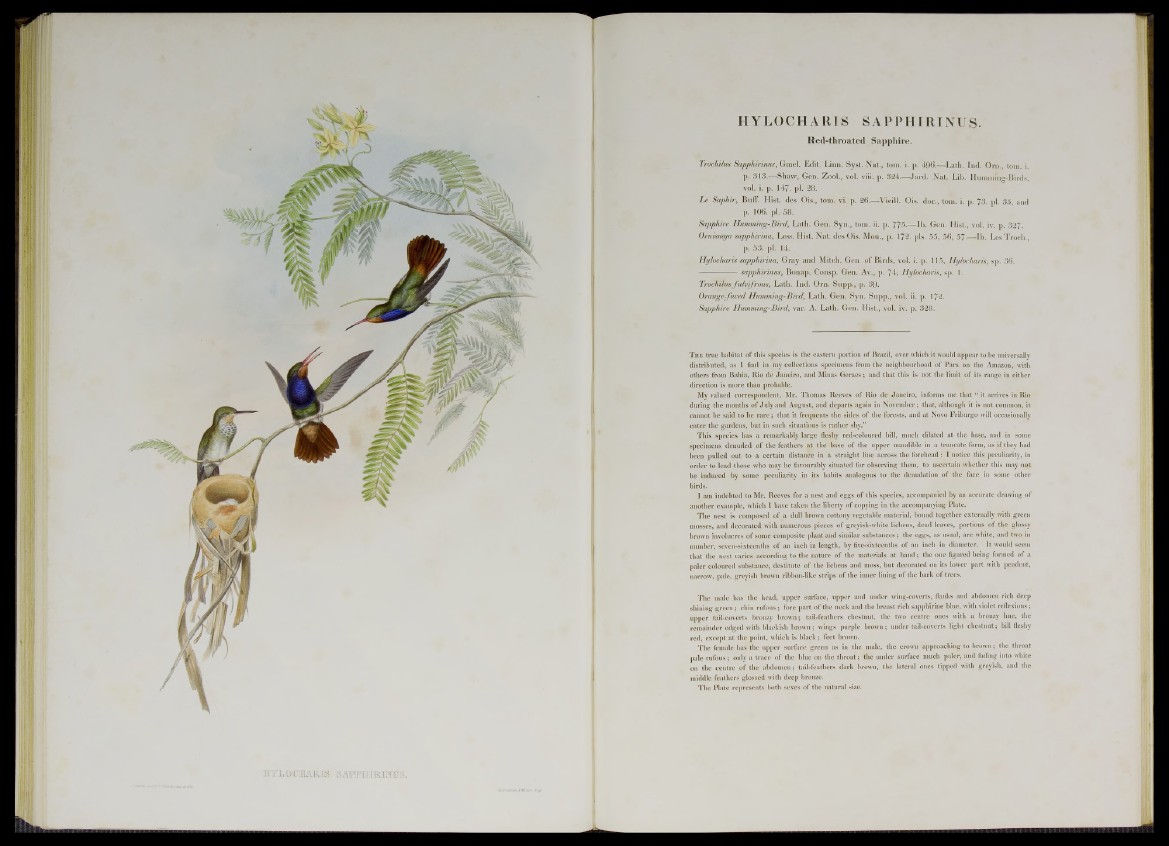
HYLOCHARIS SAPPHIRINUS.
Red-throated Sapphire.
Trochilus Sapphirinus, Gmel. Edit. Linn. Syst. N at., tom. i. p. 496.—Lath. Ind. Orn ., tom. i.
p. 313.—Shaw, Gen. Zool., vol. viii. p. 324.—J a rd . Nat. Lib. Humming-Birds,
vol. i, p. 147. pi. 28.
L e Saphir, Buff. Hist, des Ois., tom. vi. p. 26.—Vieill. Ois. dor., tom. i. p. 73. pi. 35, and
p. 106. pi. 58.
Sapphire Humming-Bird, Lath. Gen. Syn., tom. ii. p. 775.—lb . Gen. Hist., vol. iv. p. 327.
Ornistnya sapphirina, Less. Hist. Nat. des Ois. Mou., p. 172. pis. 55, 56, 57.— lb . LesTroch.,
p. 53. pi. 14.
Hylocharis sapphirina, Gray and Mitch. Gen. o f Birds, vol. i. p. 115, Hylocharis, sp. 36.
— sapphirinus, Bonap. Consp. Gen. Av., p. 74, Hylocharis, sp. 1.
T ro c h ilu s fu lv fro n s , Lath. In d . Orn. Supp., p. 39.
Orange-faced H umming-Bird, Lath. Gen. Syn. Supp., vol. ii. p. 172.
Sapphire Humming-Bird, var. A. Lath. Gen. Hist., vol. iv. p. 328.
The true habitat of this species is the eastern portion of Brazil, over which it would appear to be universally
distributed, as I find in my collections specimens from the neighbourhood of Para on the Amazon, with
others from Bahia, Rio de Janeiro, and Minas Geraes; and that this is not the limit of its range in either
direction is more than probable.
My valued correspondent, Mr. Thomas Reeves of Rio de Janeiro, informs me that “ it arrives in Rio
during the months of July and August,, and departs again in November; that, although it is not common, it
cannot be said to be ra re ; that it frequents the sides of the forests, and at Novo Friburgo will occasionally
enter the gardens, but in such situations is rather shy.”
This species has a remarkably large fleshy red-coloured bill, much dilated at the base, and in some
specimens denuded of the feathers at the base of the upper mandible in a truncate form, as if they had
been pulled out to a certain distance in a straight line across the forehead: I notice this peculiarity, in
order to lead those who may be favourably situated for observing them, to ascertain whether this may not
be induced by some peculiarity in its habits analogous to the denudation of the face in some other
birds.
I am indebted to Mr. Reeves for a nest and eggs of this species, accompanied by an accurate drawing of
another example, which I have taken the liberty of copying in the accompanying Plate.
The nest is composed of a dull brown cottony vegetable material, bound together externally with green
mosses, and decorated with numerous pieces of greyish-white lichens, dead leaves, portions of the glossy
brown involucres of some composite plant and similar substances; the eggs, as usual, are white, and two in
number, seven-sixteenths of an inch in length, by five-sixteenths of an inch in diameter. It would seem
that the nest varies according to the nature of the materials at hand; the one figured being formed of a
paler coloured substance, destitute of the lichens and moss, but decorated on its lower part with pendent,
narrow, pale, greyish brown ribbon-like strips of the inner lining of the bark of trees.
The male has the head, upper surface, upper and under wing-coverts, flanks and abdomen rich deep
shining green; chin rufous; fore part of the neck and the breast rich sapphirine blue, with violet reflexions;
upper tail-coverts bronzy brown; tail-feathers chestnut, the two centre ones with a bronzy hue, the
remainder edged with blackish brown; wings purple brown; under tail-coverts light chestnut; bill fleshy
red, except at the point, which is black; feet brown.
The female has the upper surface green as in the male, the crown approaching to brown; the throat
pale rufous; only a trace of the blue on the throat; the under surface much paler, and fading into white
on the centre of the abdomen; tail-feathers dark brown, the lateral ones tipped with greyish, and the
middle feathers glossed with deep bronze.
The Plate represents both sexes of the natural size.